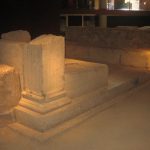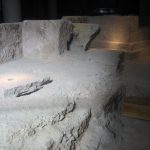Musical History
For over 2,000 years of history, Llíria and music have lived together in perfect harmony. In order to understand the history of the city, it is essential to understand its relationship with music.
Lliria from
ancient times
The musicians playing wind instruments such as double reed flutes or Greek aulós on the move, which are represented in the Iberian ceramics recovered from the archaeological site of the Tossal de Sant Miquel and exhibited in the Museum of Prehistory in Valencia, are the first example of music in the history of the Valencian Community.
These representations of Antiquity and the medieval troubadours and minstrels playing string and percussion instruments represented in the Mudejar coffered ceiling of the church of La Sangre are, without doubt, the basis of the current musical societies of Llíria.
Llíria’s well-deserved reputation as a musical city dates back to the 3rd and 2nd centuries BC, as evidenced by the Iberian ceramic vases decorated with musicians and dancers found in the Tossal de Sant Miquel.
As time went by, music began to permeate the city and in the 18th century we find a clear link between music and the Franciscan and Trinitarian convents.
But it was in the 19th century, in 1819, when a historical milestone was reached with the creation of the first civil bands in Spain (Banda Primitiva), which are still active today.
During the 1960s, the bands introduced stringed instruments, becoming symphony orchestras. In addition, the first known musical associations appeared in the Comunitat Valenciana.

On the other hand, music education has always been a fundamental pillar of the music sector. In 1993, the Professional Conservatory of Music of Llíria, which is a municipal public centre, was set up and in 1997, an important educational initiative took place, a pioneer at national level, which was the creation of the first teaching centre in Spain to integrate music into primary studies.
This was the Centre Integrat d’Ensenyaments Musicals (CIEM) La Unió Musical which used the innovative “Gabou” method to combine the learning of both types of teaching.
After 200 years of intense musical life, and due to: its national recognition, the significant volume of students currently studying music, its rich musical history and tradition, the lively music scene, and the important associationism existing around the music sector, Llíria was designated by the Valencian Parliament in October 2018 as the “Valencian City of Music” by unanimous vote of all political parties.








